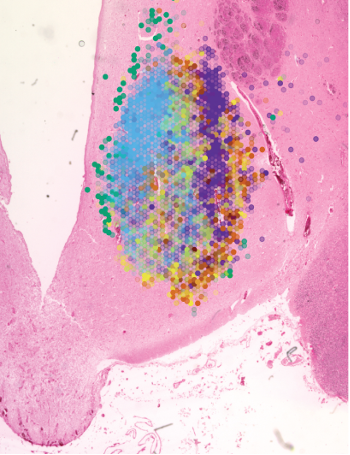Mapping the Human Hypothalamus: A Breakthrough in Understanding Metabolic Health
New atlas reveals cellular complexity of the brain’s metabolic control centre and paves the way for next-generation therapies.
 Researchers at the Institute of Metabolic Science-Metabolic Research Laboratories (IMS-MRL) and MRC Metabolic Diseases Unit at the University of Cambridge, and the Max Planck Institute for Metabolism Research in Cologne, have created the most detailed map to date of the human hypothalamus, a crucial brain region that regulates body weight, appetite, sleep, and stress. Published in Nature, this comprehensive resource, called HYPOMAP, provides an unparalleled view of the brain’s appetite centre and promises to accelerate the development of therapies for obesity and diabetes.
Researchers at the Institute of Metabolic Science-Metabolic Research Laboratories (IMS-MRL) and MRC Metabolic Diseases Unit at the University of Cambridge, and the Max Planck Institute for Metabolism Research in Cologne, have created the most detailed map to date of the human hypothalamus, a crucial brain region that regulates body weight, appetite, sleep, and stress. Published in Nature, this comprehensive resource, called HYPOMAP, provides an unparalleled view of the brain’s appetite centre and promises to accelerate the development of therapies for obesity and diabetes.
The hypothalamus is often described as the brain’s “control centre,” orchestrating many of the body’s most vital processes. While much of our knowledge of the hypothalamus comes from animal studies, especially in mice, translating these findings to humans has long been a challenge. HYPOMAP bridges this gap by providing an unprecedented atlas of the individual cells within the human hypothalamus. This resource not only charts over 450 unique cell types but also highlights key differences between the human and mouse hypothalamus—differences that have major implications for drug development.
“This is a game-changer for understanding the human hypothalamus,” said Professor Giles Yeo, senior author of the study from the IMS-MRL. “HYPOMAP confirms the critical role of the hypothalamus in body-weight regulation and has already allowed us to identify new genes linked to obesity. It gives us a roadmap to develop more effective, human-specific therapies.”
A Google Maps for the Brain
Using cutting-edge single-cell and spatial transcriptomic technologies, the researchers analysed over 400,000 cells from 18 human donors. HYPOMAP acts like a “Google Maps” for the hypothalamus, allowing researchers to pinpoint specific cell types, understand their genetic profiles, and explore how they interact with neighbouring cells. This detailed cellular resolution offers invaluable insights into the circuits that regulate appetite and energy balance, as well as other functions such as sleep and stress responses.
Therapeutic Insights: What Makes Humans Unique?
Comparison with a mouse hypothalamus atlas revealed both similarities and critical differences. Notably, some neurons in the mouse hypothalamus express receptors for GLP-1—targeted by popular weight-loss drugs like semaglutide—that are absent in humans. "While drugs like semaglutide have shown success in treating obesity, newer therapies target multiple receptors such as GLP-1R and GIPR. Understanding how these receptors function specifically in the human hypothalamus is now crucial for designing safer and more effective treatments" explains Dr Georgina Dowsett, one of the authors of the study.
“Our map of the human hypothalamus is an essential tool for basic and translational research,” explained Professor Jens C. Brüning, Director at the Max Planck Institute. “It allows us to pinpoint which mouse nerve cells are most comparable to human cells, enabling more targeted preclinical studies.”
A Milestone for Brain and Metabolic Research
HYPOMAP’s open-access nature ensures that it will be an invaluable resource for scientists worldwide. By offering insights into the hypothalamus’s role in conditions ranging from obesity to cachexia, it provides a foundation for tackling some of the most pressing health challenges of our time.
“This is just the beginning,” said Dr John A. Tadross, Consultant Pathologist at Addenbrooke’s Hospital and lead author from the IMS-MRL. “The atlas itself is a milestone, but what could really make a difference for patients is understanding how the hypothalamus changes in people who are overweight or underweight. This could fundamentally shift our approach to metabolic health and enable more personalised therapies.”
With HYPOMAP, researchers have a new tool to unlock the secrets of the human brain’s metabolic control centre. By better understanding the human hypothalamus, science takes a significant step toward combating obesity, diabetes, and related conditions.
Reference:
John A. Tadross, Lukas Steuernagel, Georgina K.C. Dowsett, Katherine A. Kentistou, Sofia Lundh, Marta Porniece, Paul Klemm, Kara Rainbow, Henning Hvid, Katarzyna Kania, Joseph Polex-Wolf, Lotte Bjerre Knudsen, Charles Pyke, John R. B. Perry, Brian Y.H. Lam, Jens C. Brüning, Giles S.H. Yeo. A comprehensive spatio-cellular map of the human hypothalamus Nature DOI 10.1038/s41586-024-08504-8
Caption: Spatio-cellular integration illuminates the architectural organisation of distinct ventromedial hypothalamus neuronal subtypes

